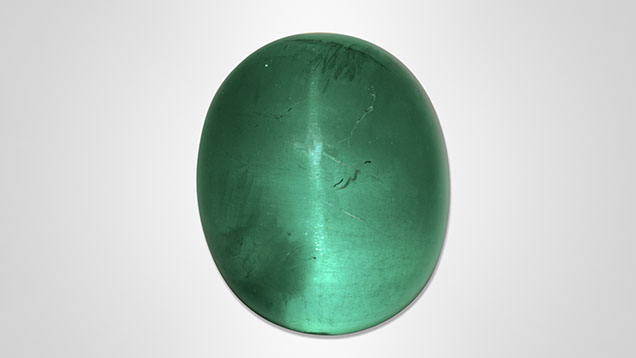An Extraordinarily Large Cat’s-Eye Emerald

Emerald in cabochon form sometimes displays a chatoyant effect, and comparatively large cat’s-eye emeralds are highly sought after. GIA’s Tokyo laboratory recently examined an extraordinarily large semitransparent green cabochon measuring 31.3 × 26.2 × 20.9 mm and weighing approximately 126 ct (figure 1). The stone had a spot refractive index of 1.58 and showed specific chromium absorption lines in the red through a handheld spectroscope, and standard gemological properties identified it as emerald.

The emerald contained numerous reflective rain-like inclusions creating a chatoyant effect (figure 2A), whitish granular flake-like inclusions (figure 2B), and aggregates of tiny whitish crystals which were identified as feldspar by Raman spectroscopic analysis (figure 2C). The ultraviolet/visible/near-infrared absorption spectra showed two broad bands of Cr3+ at 430 and 600 nm, with a large Fe2+ band at around 850 nm and an Fe3+ broad band at 372 nm. Trace element chemical results using laser ablation–inductively coupled plasma–mass spectrometry showed that this emerald had a high iron concentration (2800–2930 ppmw) and medium potassium range (67.8–74.3 ppmw), characteristics similar to the published data of emeralds from the Belmont mine in Minas Gerais, Brazil (e.g., S. Saeseaw et al., “Geographic origin determination of emerald,” Winter 2019 G&G, pp. 614–646). Inclusions observed in this emerald were also consistent with a Brazilian origin (again, see figure 2).
Brazil is a well-known source of large emerald crystals. One previous report (Summer 2015 Gem News International, pp. 200–201) described a 43 ct Brazilian cat’s-eye emerald. The cat’s-eye emerald examined here is notable for its size and transparency, and it is one of the largest examined by a GIA laboratory to date.



